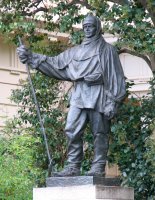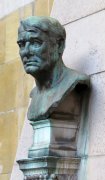Lady Kathleen Scott [Baroness Kennet] (1878-1947)
The sculptor Lady Kathleen Scott, later Baroness Kennet, is best known for her statue of her husband, Captain Scott of the Antarctic, in Waterloo Place, London, and has several other bronze portrait statues dotted around the country; her main oeuvre consisted of portrait busts.
Scott of the Antarctic, Waterloo Place.
Kathleen Scott, born Kathleen Bruce, in Nottinghamshire, studied at the Slade in London from 1900, followed by four years in Paris where she met Rodin (though was not his pupil), and in Italy, before returning to London in 1906 to pursue her career as a professional sculptor. She married Capt. Scott in 1908, and was widowed just four years later, becoming Baroness Kennet by marriage to Hilton Young, Baron Kennet, in 1922 - she continued however to sign her works as ‘K Scott’ thereafter. From the late 1920s she lived in Lancaster Gate, London, moving in high society.
Her specialism was portrait busts, and her output fairly prolific. Along with the Captain Scott in Waterloo Place, dated 1915, copied I believe from the white marble version of the same year in Christchurch, New Zealand, and she made another bronze of him without the baggy exploring costume in Portsmouth. There are several other public portrait statues by her – Commander E.J. Smith (captain of the Titanic) in Lichfield, Charles Rolls in Dover, and Edward Wilson in Cheltenham. Among her busts, we may mention two in London: the monument to Lord Northcliffe, bronze with a tall obelisk in stone behind, outside St Dunstan in the West, Fleet Street, and Adam Lindsay Gordon, a stone bust in Westminster Abbey.
She also made a small number of ideal nude male figures, mostly maquette sized, but including the full sized Ad Astra in Welwyn Garden City, and better known, Youth, which has other names too, who stands hands outstretched, head dramatically tilted back, outside the Scott Institute, Cambridge (a bust of Capt Scott is also there). There seems to be at least one reduced size version of this statue. And one war memorial, for Huntingdon, also in Cambridgeshire, called The Thinking Soldier.
She wrote extensive diaries, from which a book was compiled, ‘Self Portrait of an Artist’.
Lord Northcliffe monument.

